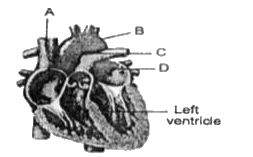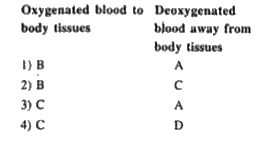When a human being is cold, the superficial blood vessels :
dilate, and the sweat glands are inactive
dilate, and the sweat glands are active
constrict, and the sweat glands are inactive
constrict, and the sweat glands are active
The correct Answer is:C
Step-by-Step Solution:
1. Understanding the Question: The question asks what happens to the superficial blood vessels in a human being when the body is exposed to cold temperatures.
2. Identifying the Response to Cold: When the body is cold, it needs to conserve heat. One of the physiological responses to cold is vasoconstriction.
3. Defining Vasoconstriction: Vasoconstriction is the process where blood vessels narrow (constrict), which reduces blood flow to the surface of the skin. This helps to retain body heat by minimizing heat loss to the environment.
4. Effects on Blood Pressure: As the superficial blood vessels constrict, blood pressure in these vessels increases. This is a natural response to maintain core body temperature.
5. Impact on Sweat Glands: In cold conditions, sweat glands become inactive. This is because sweating is a mechanism used to cool the body down, and it is not needed when the body is trying to conserve heat.
6. Evaluating the Options: The options provided in the question likely include:
- Constrict and sweat glands are inactive.
- Dilate and sweat glands are inactive.
- Dilate and sweat glands are active.
- Constrict and sweat glands are active.
Based on the physiological responses discussed:
- The correct answer is that the superficial blood vessels constrict and the sweat glands are inactive.
7. Conclusion: Therefore, when a human being is cold, the superficial blood vessels constrict, and the sweat glands become inactive.
Final Answer: The superficial blood vessels constrict, and the sweat glands are inactive.
---
- Constrict and sweat glands are inactive.
- Dilate and sweat glands are inactive.
- Dilate and sweat glands are active.
- Constrict and sweat glands are active.
- The correct answer is that the superficial blood vessels constrict and the sweat glands are inactive.
Topper's Solved these Questions
- BOOK - ICSECHAPTER - STRUCTURAL ORGANISATION IN ANIMALS EXERCISE - Test Your Progress (Fill in the blanks with appropriate words)20videos
STRUCTURAL ORGANISATION IN ANIMALS
- BOOK - ICSECHAPTER - STRUCTURAL ORGANISATION IN ANIMALS EXERCISE - Test Your Progress (State whether the following statements are true or false )15videos
STRUCTURAL ORGANISATION IN ANIMALS
- BOOK - ICSECHAPTER - SELF ASSESSMENT PAPER-3EXERCISE - PART II (SECTION C)4videos
SELF ASSESSMENT PAPER-3
- BOOK - ICSECHAPTER - STRUCTURE ORGANISATION IN ANIMALS -ANIMAL TISSUESEXERCISE - REVIEW QUESTIONS (LONG ANSWER TYPE QUESTIONS)12videos
STRUCTURE ORGANISATION IN ANIMALS -ANIMAL TISSUES
Similar Questions
Human beings are
View SolutionHuman beings are
View SolutionHuman beings are
View SolutionHuman beings are
View SolutionName the smallest blood vessel.
View SolutionHuman being is hungry when
View SolutionThe finest of all blood vessels are the
View SolutionBlood of human beings contain
View SolutionWhat is the effect of ADH on blood vessels?
View SolutionThe diagram shows the heart with its main blood vessels

Which blood vessels carry oxygenated blood to the body tissues and deoxygenated blood away from the body tissues ?
 View Solution
View Solution

